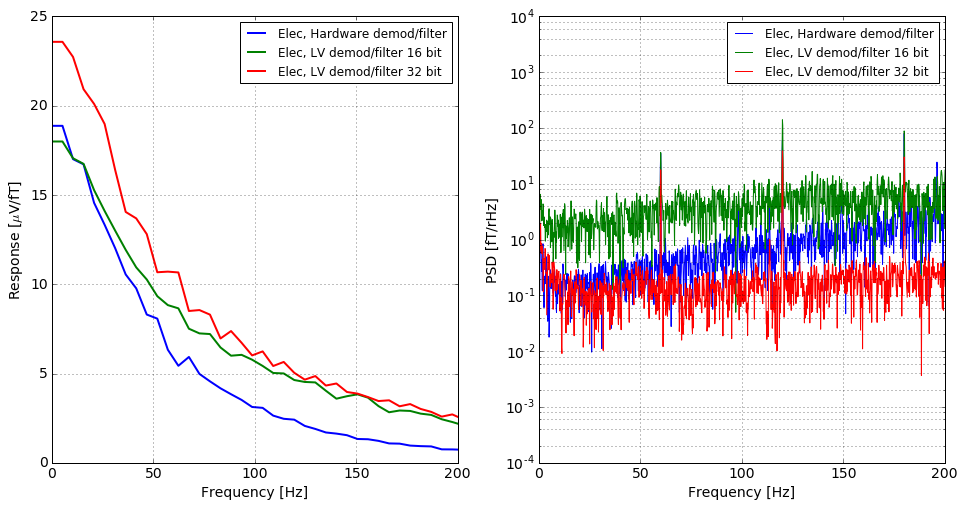Lena/Sep 2016: Difference between revisions
(→PSD) |
(→PSD) |
||
| Line 80: | Line 80: | ||
The 32-bit version performs as good as the hardware lock-in. For some reason, the hardware lock-in PSD noise increases for higher frequencies, and for the 32-bit FPGA lockin it doesn't. The 32-bit version has 50 times smaller noise level than the 16-bit version. |
The 32-bit version performs as good as the hardware lock-in. For some reason, the hardware lock-in PSD noise increases for higher frequencies, and for the 32-bit FPGA lockin it doesn't. The 32-bit version has 50 times smaller noise level than the 16-bit version. |
||
NoiseCompare(day='2016.08.31', run='14', noise='02', bs=1, Chan=1, direc='Y', label='Elec, Hardware demod/filter', ver='v16', fmax=200, |
NoiseCompare(day='2016.08.31', run='14', noise='02', bs=1, Chan=1, direc='Y', label='Elec, Hardware demod/filter', ver='v16', fmax=200, |
||
radresp=0, calib=2e-06, Ipr=0.0001, psn=0); |
|||
NoiseCompare(day='2016. |
NoiseCompare(day='2016.08.31', run='00', noise='02', bs=1, Chan=1, direc='Y', label='Elec, LV demod/filter 16 bit', ver='v16', fmax=200, |
||
radresp=0, calib=2e-06, Ipr=0.0001, psn=0); |
|||
NoiseCompare(day='2016.09.16', run='32', noise='02', bs=1, Chan=1, direc='Y', label='Elec, LV demod/filter 32 bit', ver='v16', fmax=200, |
|||
radresp=0, calib=2e-06, Ipr=0.0001, psn=0); |
|||
[[File:Electronic noise comparison 2016 09 16.png]] |
[[File:Electronic noise comparison 2016 09 16.png]] |
||
Revision as of 20:34, 16 September 2016
September 2016
BACK/NEXT
09/01/2016
Moving modulation/demodulation into LUT
Started on addressing the problems in the LabVIEW VIs. The first problem are the overflows in modulation/demodulation paths. The problem is that two 16-bit words are multiplied and they result in a 32 bit word, which is then scaled to fit back into a 16-bit word, and the scaling is not done correctly. I updated the VI, but it wouldn't compile because the compiler ran out of DSP48 blocks. The solution was to replace the Numeric multiplication blocks with High-throughput multiplication blocks and set the implementation to Look-Up Table, as described in this link http://forums.ni.com/t5/LabVIEW/Large-FPGA-vi-compiled-in-LV-2009-but-not-2010/m-p/1678820#M597625
Lab meeting
- File:2016.09.01 Group Meeting.pdf
- Thad suggested that we should have a logarithmic amplifier (so the signal is large enough for the ADC), and a PID loop at sub-Hz frequency to get rid of the DC fields around the sensor array.
09/01/2016
Talked to Mike about the insufficient bit resolution problem. Mike says the correct averaging should give us effectively more bits http://www.analog.com/library/analogDialogue/archives/40-02/adc_noise.html This should work as long as we increase the number of bits after the averaging.
09/08/2016
Implementing Mike's suggestions in LabVIEW (because it's easier to change the code than the hardware). The code mostly works, but still needs some debugging to make it compatible with the heartbeat recording VI.
Changes made compared to the previous version:
- Data is acquired at the maximum ADC rate of 500 ksps
- Raw ADC data is scaled up to int32 from int16 and anti-aliased by a rational resampler. The output data rate is ~20 ksps (2011 ticks at 40 MHz instead of expected 2000 ticks).
- Data is low-pass filtered at 250 Hz by a 6-pole Bessel filter.
- Data is sent to the PC with 32 bit resolution
09/12/2016
The LabVIEW VI's turned out to be way harder to maintain than I anticipated. For this reason, I cleaned up the project by selecting only the files necessary for the fMCG magnetometer to run (reduced the folder size from 1 GB to about 50 MB) and initialized a GitHub repo in the project folder. The project is pushed to this private GitHub repo: https://github.com/lenazh/fMCG-LabView-VIs
09/16/2016
The 32-bit magnetometer LabVIEW VI finally is working. Took several measurements to compare the noise performance of the 16-bit and the 32-bit VIs. Also measured how magnetic is a thermoresistor used in a different experiment in Chamberlain.
Measurements
| Day | Run | Noise | Comment |
|---|---|---|---|
| 2016.09.16 | 25 | 00 | Z mode, 16 bit, with RTD, magnetic noise |
| 2016.09.16 | 25 | 01 | Z mode, 16 bit, with RTD, technical noise |
| 2016.09.16 | 26 | 00 | Z mode, 16 bit, no RTD, magnetic noise |
| 2016.09.16 | 26 | 01 | Z mode, 16 bit, no RTD, technical noise |
| 2016.09.16 | 28 | 00 | Z mode, 32 bit, no RTD, magnetic noise |
| 2016.09.16 | 28 | 01 | Z mode, 32 bit, no RTD, technical noise |
| 2016.09.16 | 32 | 00 | Z mode, 32 bit, with RTD, magnetic noise |
| 2016.09.16 | 32 | 01 | Z mode, 32 bit, with RTD, technical noise |
| 2016.09.16 | 32 | 02 | Z mode, 32 bit, no RTD, electronic noise |
| 2016.08.31 | 14 | 02 | Z mode, Hardware demodulation (SR830) |
| 2016.08.31 | 00 | 02 | Z mode, 16 bit, no RTD, electronic noise |
RTD
The RTD (model) doesn't seem to be magnetic.
Noise comparison
PSD
The 32-bit version performs as good as the hardware lock-in. For some reason, the hardware lock-in PSD noise increases for higher frequencies, and for the 32-bit FPGA lockin it doesn't. The 32-bit version has 50 times smaller noise level than the 16-bit version.
NoiseCompare(day='2016.08.31', run='14', noise='02', bs=1, Chan=1, direc='Y', label='Elec, Hardware demod/filter', ver='v16', fmax=200, radresp=0, calib=2e-06, Ipr=0.0001, psn=0); NoiseCompare(day='2016.08.31', run='00', noise='02', bs=1, Chan=1, direc='Y', label='Elec, LV demod/filter 16 bit', ver='v16', fmax=200, radresp=0, calib=2e-06, Ipr=0.0001, psn=0); NoiseCompare(day='2016.09.16', run='32', noise='02', bs=1, Chan=1, direc='Y', label='Elec, LV demod/filter 32 bit', ver='v16', fmax=200, radresp=0, calib=2e-06, Ipr=0.0001, psn=0);
The data is acquired at the sampling rate of 500 ksps, and then averaged to approximately 200 sps (final FPGA filter has fc=180 Hz). This should improve the bit resolution by a factor of Sqrt(500 ksps/200 sps) = Sqrt(2500) = 50 (6-7 bits).
The estimated gain was 25 μV/fT. The LSB voltage step is 300 μV, the effective LSB after averaging should be 300/50 = 6 μV = 0.25 fT.
Filtering/digitization
The digitization of the signal is not visible in the 32 bit version.
(image here)
